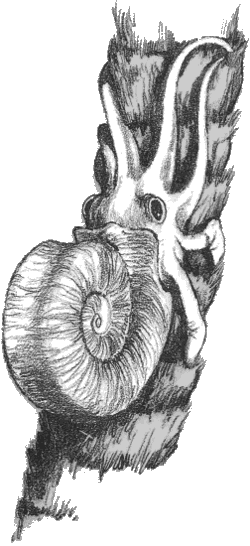
Dougal Dixon's book The New Dinosaurs: An Alternative Evolution (1988) imagines what life would look like if the Cretaceous-Tertiary extinction event had not happened and non-avian dinosaurs had continued evolving over the last 65 million years.
Besides the eponymous new dinosaurs, one of his hypothetical creatures inhabiting the Australasian Realm is the coconut grab (Nuctoceras litureperus), a type of tree-climbing ammonite:
The coconut grab is an unusual ammonite in that it can spend much of its time out of the water crawling about on land. On many of the tropical islands of the ocean it can crawl up the beach and eat coconuts, and even climb trees to find the nuts when there are none available lying in the sand or washed up on the shore.
It's preyed upon by a flightless, tree-climbing pterosaur called a shorerunner.
In Dixon's hypothetical present, tropical tree octopuses apparently never had a chance to evolve, which is probably just as well for the dinosaurs.

The coiled shell of the coconut grab is flat on the bottom, providing a skid-like surface that allows it to be dragged over the sand. There are eight tentacles. The four at the rear are broad and very muscular. They are used for pulling the animal over the ground and up coconut palms. The front four tentacles are long and delicate, allowing the ammonite to reach for a coconut. The eyes can focus both submerged and out of the water. Coconut grabs usually come ashore at night when it is cooler, and dawn finds the beach criss-crossed by their distinctive trails.
The New Dinosaurs is out of print, but you can read it here (the coconut grab is on p. 98). There's also some higher-res scans here.
For those unfamiliar with him, Dixon is perhaps best known for his two books of speculative future evolution, After Man and Man After Man. He also wrote the companion book for the miniseries The Future Is Wild, which featured tree-climbing squid called squibbons and a forest-dwelling megasquid.
